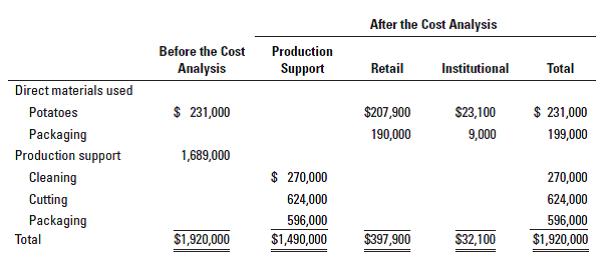Question
Intex Potatoes (IP) operates at capacity and processes potatoes into potato cuts at its highly automated Pocatello plant. It sells potatoes to the retail consumer
Intex Potatoes (IP) operates at capacity and processes potatoes into potato cuts at its highly automated Pocatello plant. It sells potatoes to the retail consumer market and to the institutional market, which includes hospitals, cafeterias, and university dormitories. IP’s simple costing system, which does not distinguish between potato cuts processed for retail and institutional markets, has a single direct-cost category (direct materials; that is, raw potatoes) and a single indirect-cost pool (production support). Support costs, which include packaging materials, are allocated on the basis of pounds of potato cuts processed. The company uses 1,800,000 pounds of raw potatoes to process 1,600,000 pounds of potato cuts. At the end of 2014, IP unsuccessfully bid for a large institutional contract. Its bid was reported to be 30% above the winning bid. This feedback came as a shock because IP included only a minimum profit margin on its bid, and the Pocatello plant was acknowledged as the most efficient in the industry. As a result of its review process of the lost contract bid, IP decided to explore ways to refine its costing system. The company determined that 90% of the direct materials (raw potatoes) related to the retail market and 10% to the institutional market. In addition, the company identified that packaging materials could be directly traced to individual jobs ($190,000 for retail and $9,000 for institutional). Also, the company used ABC to identify three main activity areas that generated support costs: cleaning, cutting, and packaging. ¦ Cleaning Activity Area—The cost-allocation base is pounds of raw potatoes cleaned. ¦ Cutting Activity Area—The production line produces (a) 150 pounds of retail potato cuts per cutting-hour and (b) 200 pounds of institutional potato cuts per cutting-hour. The cost-allocation base is cutting-hours on the production line. ¦ Packaging Activity Area—The packaging line packages (a) 25 pounds of retail potato cuts per packaging- hour and (b) 80 pounds of institutional potato cuts per packaging-hour. The cost-allocation base is packaging-hours on the production line. The following table summarizes the actual costs for 2014 before and after the preceding cost analysis.

1. Using the simple costing system, what is the cost per pound of potato cuts produced by IP?
2. Calculate the cost rate per unit of the cost driver in the (a) cleaning, (b) cutting, and (c) packaging activity areas.
3. Suppose IP uses information from its activity cost rates to calculate costs incurred on retail potato cuts and institutional potato cuts. Using the ABC system, what is the cost per pound of (a) retail potato cuts and (b) institutional potato cuts?
4. Comment on the cost differences between the two costing systems in requirements 1 and 3. How might IP use the information in requirement 3 to make better decisions?
Direct materials used Potatoes Packaging Production support Cleaning Cutting Packaging Total Before the Cost Analysis $ 231,000 1,689,000 $1,920,000 Production Support $ 270,000 624,000 596,000 $1,490,000 After the Cost Analysis Retail $207,900 190,000 $397,900 Institutional $23,100 9,000 $32,100 Total $ 231,000 199,000 270,000 624,000 596,000 $1,920,000
Step by Step Solution
3.52 Rating (162 Votes )
There are 3 Steps involved in it
Step: 1
Answer 1 ABC activity area costdriver rates product crosssubsidization 1 Direct costs Direct materials 150000 Indirect costs Product support 983000 Total costs 1133000 Cost per pound of potato cuts 11...
Get Instant Access to Expert-Tailored Solutions
See step-by-step solutions with expert insights and AI powered tools for academic success
Step: 2

Step: 3

Ace Your Homework with AI
Get the answers you need in no time with our AI-driven, step-by-step assistance
Get Started


